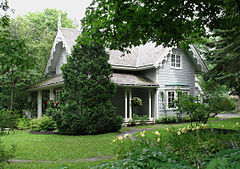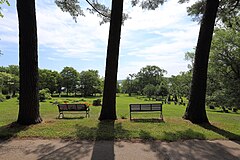Sillery Heritage Site
| Sillery Heritage Site | |
|---|---|
| Native name French: Site patrimonial de Sillery | |
| Arrondissement historique de Sillery | |
 View of Saint-Michel de Sillery Church | |
| Type | Heritage District |
| Etymology | Noël Brûlart de Sillery |
| Location | 
|
| Coordinates | 46°46′38.5″N 71°14′45.49″W / 46.777361°N 71.2459694°WCoordinates: 46°46′38.5″N 71°14′45.49″W / 46.777361°N 71.2459694°W |
| Settled | 1637[1] |
| Founder |
|
| Built for |
|
| Original use | Saint-Joseph Mission of Sillery — Jesuit mission to members of the First Nations |
| Governing body |
|
| Official name | Site patrimonial de Sillery |
| Type | Patrimoine immobilier (Heritage immovable property) |
| Designated | 5 February 1964[2][3] |
| Reference no. | 93522 |
| Former name | Arrondissement historique de Sillery |
| Recognition statute | Loi sur les biens culturels (Cultural Property Act) |
The Sillery Heritage Site (French: site patrimonial de Sillery), formerly known as the Sillery Historic District (French: arrondissement historique de Sillery), is a territory containing historic residential and institutional properties, as well as woodlands, located in the Sainte-Foy–Sillery–Cap-Rouge borough of Quebec City, Quebec, Canada. It is one of four heritage sites which are located in the City of Quebec.[1] Having been called the "cradle of the Quebec nation,"[4] it includes approximately 350 buildings situated on a linear 3.5 kilometres (2.175 miles) wide[3][4] landscape, which is alongside, as well as an integral part of the coast of the Saint Lawrence River. The built environment was constructed in all of the time periods, including and following the foundation of New France (French: Nouvelle-France).
Amongst the district's properties are the early 18th century Jesuit House of Sillery (French: maison des Jésuites-de-Sillery),[5][6] 19th century workers' homes on Foulon Road (French: chemin du Foulon (also known during this time period by the English name Cove Road))[7] and the Sillery coast (near Saint-Michel of Sillery Church (French: église Saint-Michel de Sillery), villas built by wood barons in the 19th century, and institutional properties built at the turn of the 20th century.[8]
Heritage designation began as early as 1929, when the Jesuit House was assigned protective status.[9] The entire territory was officially recognized as a heritage site by the Government of Quebec (French: Gouvernement du Québec) on 5 February 1964.[2][3] The heritage site was placed on the Parks Canada's administered Canadian Register of Historic Places (CRHP; (French: Répertoire canadien des lieux patrimoniaux), also known as Canada's Historic Places, on 22 June 2006.[3] The site's provincial heritage registry listing includes five categorical groups of associated elements: 627 heritage immovable / real property assets, nine associated movable heritage objects, 18 related commemorative plaques, two associated groups, and three associated people.
While recognizing the visionary action taken by Quebec's Ministry of Culture (French: ministère de la Culture), in the 1960s, by conferring historic status upon the district to protect it from suburban developers, the National Trust for Canada (French: Fiducie nationale du Canada), a registered charity, placed the Sillery Historic District on its Top 10 Endangered Places list (French: Palmarès des 10 sites les plus menacés), in the early 2010s, due to the approval of condominium developments which encroached upon historic religious properties in the district.[4][10] In 2015, the City of Quebec announced that it would encourage any future developers to restore historic religious structures which were no longer owned by their former communities, in exchange for the allowance to undertake development on the surrounding lands. The city argued that some development was necessary to provide tax revenue in order to sustain the preservation of the historic district.[4] The Trust has subsequently removed the Sillery Historic District from its endangered list, and archived its status as a past listing, amongst other properties, spread across all of Canada's provinces and territories.[4]
Historic properties located on the heritage site[]
- Spencer Grange, 1328, avenue Duquet
- Canadian Montmartre and Sanctuary of the Sacred Heart (French: Montmartre Canadien et Sanctuaire du Sacré-Cœur), 1669, chemin Saint-Louis
- Villa Benmore, 2071, chemin Saint-Louis
- Villa Clermont, 2211, chemin Saint-Louis
- Bignell House (French: maison Bignell), 1524, côte à Gignac
- Timmony House (French: maison Timmony), 2014, rue Louis-H. Lafontaine
Bibliography[]
- "Visual Perspectives — Appendix XI.7 — Plan 1 of 1" (PDF). Planning and Conservation Commission, City of Quebec. Department of Legal Affairs, City of Quebec. October 2015.
- "List of Historic Buildings located on the Sillery Heritage Site — Appendix XI.7" (PDF). Planning and Conservation Commission, City of Quebec. Department of Legal Affairs, City of Quebec. October 2015.
- "2016 Map of the Heritage Site" (PDF). Department of Planning and Urban Development, Architecture and Heritage Division. Department of Legal Affairs, City of Quebec. 2016.
- Plan de conservation — site patrimonial de Sillery (PDF). ministère de la Culture et des Communications (in French). July 2013. ISBN 978-2-550-65817-7.
Related articles[]
External links[]
| Wikimedia Commons has media related to Sillery Heritage Site. |
- "Sillery Heritage Site". Québec City Tourism — Official Web Site.
- "Podcast tour of Sainte-Foy—Sillery—Cap-Rouge Heritage Site". Québec City Tourism — Official Web Site.
- "Sillery and the historic role of Sillery Sandstone". Ministry of Energy and Natural Resources (MERN).
- "The Sillery Irish — slideshow". Irish Heritage Quebec.
- "Map: An Authentic Plan of the River St. Laurence from Sillery, to the Fall of Montmorenci, with the Operations of the Siege of Quebec under the Command of Vice-Adml. Saunders & Major Genl. Wolfe down to the 5 Sepr. 1759, London: published by Thomas Jefferys, circa 1759". Massachusetts Historical Society.
- "New conservation plan for Sillery heritage site". Quebec Chronicle-Telegraph. Quebec. 2013-07-24.
References[]
- ^ Jump up to: a b "À propos de la ville – Portrait – Géographie – Sainte-Foy–Sillery–Cap-Rouge". Ville de Québec (in French). 2018. Archived from the original on 2018-10-07. Retrieved 2018-10-07.
- ^ Jump up to: a b c "Site patrimonial de Sillery — Fiche de l'élément — Répertoire du patrimoine culturel du Québec". ministère de la Culture et des Communications (in French). Archived from the original on 2015-09-24. Retrieved 2018-10-05.
- ^ Jump up to: a b c d Arrondissement historique de Sillery. Canadian Register of Historic Places. Retrieved 2018-10-03.
- ^ Jump up to: a b c d e "Sillery District — Issues & Campaigns — Top 10 Endangered Places — Explore Past Listings — Quebec". National Trust for Canada. Archived from the original on 2018-10-03. Retrieved 2018-10-03.
- ^ Légaré, Denyse; Labrecque, Paul (2008). Division de la culture, du loisir et de la vie communautaire de l'Arrondissement de Sainte-Foy—Sillery (ed.). Histoire de raconter — L'arrondissement historique de Sillery — Arrondissement de Sainte-Foy—Sillery [Storytelling — The Historic District of Sillery — Borough of Sainte-Foy—Sillery] (PDF). Itinéraires histoire et patrimoine (in French). Québec: Division de la culture, du loisir et de la vie communautaire de l'Arrondissement de Sainte-Foy—Sillery. ISBN 978-2-89552-058-0. Archived (PDF) from the original on 2018-10-11. Retrieved 2018-10-11.
- ^ "Maison des Jésuites de Sillery — Museums and historic sites — Heritage sites and attractions — Things to do". QuébecOriginal. Archived from the original on 2018-10-05. Retrieved 2018-10-05.
- ^ "Citoyens — Patrimoine — Toponymie — Fiche — Foulon — Chemin du". Ville de Québec (in French). Archived from the original on 2018-10-05. Retrieved 2018-10-05.
- ^ Lapointe, Pierre Louis (2015-03-04). Sillery (Qué). The Canadian Encyclopedia. ISBN 978-0-77102-099-5. OCLC 904169186. OL 8533423W. Archived from the original on 2018-10-03. Retrieved 2018-10-03.
- ^ "Patrimoine Culturel — Sites patrimoniaux déclarés — Sillery — Site patrimonial de Sillery". Conseil du patrimoine culturel du Québec (in French). Archived from the original on 2018-10-07. Retrieved 2018-10-07.
- ^ "The future of the Sillery heritage site". Quebec AM, CBC Montreal. 2013-04-02. Retrieved 2018-10-03.
- Heritage immovables of Quebec
- French Colonial architecture in Canada
- Buildings and structures in Quebec City
- French mission settlements in North America
- Sillery, Quebec City













